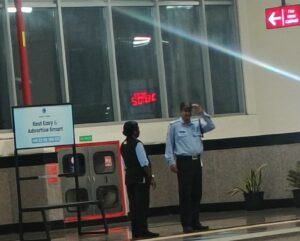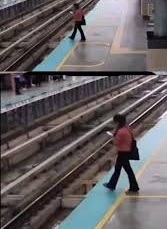Installing platform screen doors will prevent people from accidentally falling on the railroad, as well as stop attempts to die by suicide to a certain extent.
Published Aug 13, 2025 | 9:00 AM ⚊ Updated Aug 13, 2025 | 9:00 AM

And one question lingers above them all, is Kochi Metro as safe as we believe?
Synopsis: Kerala saw a young man’s plunge to death on videos circulated on social media. Even as Kochi Metro has implemented tight safety measures, commuters seek more to avoid such incidents, and accidents like a recent one, in which a woman fell onto the tracks and fortunately, survived.
Nizar seemed determined. “Why live a shameful life?” he reportedly screamed at those trying to dissuade him from taking the final plunge.
The 32-year-old Malappuram resident scaled the railings of the Kochi Metro Rail Limited (KMRL)’s viaduct between Vadekkekota and SN Junction stations and leapt off. Some 40 metres below, the Fire and Rescue Department personnel were ready with a safety net.
Nizar, however, did not land on the net. He hit the asphalt road and was grievously injured. Visuals of the man climbing and leaping over the edge of the viaduct went viral on social media. The gory sight shocked many.
The Metro’s security personnel had reportedly seen him on the platform. He had not boarded a train despite having a valid ticket. Instead, he jumped onto the tracks and ran about 150 metres even as the security activated the Emergency Trip Switch (ETS), cutting the power supply to the third rail running parallel to the tracks to avoid a possible electrocution.

Nizar.
The man did not heed the security personnel who followed him. He threatened to jump off the viaduct if they closed in. The Fire Force and the police were alerted, and they reached the scene.
All efforts to dissuade the youth failed. An injured Nizar was rushed to the nearby VKM Hospital, where he was administered first aid. Though he was shifted to the Medical Trust Hospital, doctors there declared him “dead on arrival”.
The halted Metro services on the stretch resumed after 40 minutes, as many searched for answers. The incident reminded them of a young woman who had recently fallen onto the Metro tracks. She was distracted by her mobile phone and took a misstep that sent her tumbling.
The woman was lucky. She survived.
Two incidents in such quick succession have unsettled commuters. The questions now are heavier. One question lingers above them all: Is Kochi Metro safe?
The answer is short: Metro is safe. In one case, the man was determined and tragically focused on what he had planned. On the other hand, the woman’s focus was on her phone, and she did not watch her step.

Security personnel at the Vadekkekotta Metro Station.
”The Metro is a specialised infrastructure, and our security arrangements are well in place,” the KMRL’s Chief Security Officer, Jijimon, told South First. The recent suicide incident was deliberate, and unfortunately, there are limitations in preventing such intentional acts. Nizar was not mentally well. Stopping a determined person from such attempts is not easy.”
KMRL has deployed its security personnel at all platforms, with separate teams to check baggage and detect banned items. Additionally, it has a dedicated police station.
“Across the 25 stations from Aluva to Tripunithura, we have about 500 security staff working in shifts,” Jijimon said.
He also mentioned the young woman who fell onto the tracks. “She was talking on her mobile phone. It was a case of negligence. In both cases, the security teams intervened promptly. We even used the girl’s video in our social media awareness campaign,” the security chief added.
Soon after Nizar’s fatal leap, KMRL announced a director-level investigation into the incident. It termed the incident ”extremely unfortunate.
Director (Systems) will lead the probe to determine the sequence of events and recommend preventive measures.
Metro’s statement said Nizar entered the viaduct track between Vadakkekota and SN Junction stations at approximately 2.04 pm on 7 March. The security staff activated the Emergency Trip Switch (ETS) immediately, cutting power to the third rail. Metro operations and security teams responded on-site, while senior officials, police, and fire services were alerted.
To manage service disruption, short-loop operations were introduced between Aluva and Kadavanthra. Despite rescue attempts, the passenger leapt from the viaduct to the road below at 2.36 pm. Emergency responders were on location to handle the situation.
The track was cleared at 2.43 pm., and normal services between Kadavanthra and Tripunithura resumed at 2.44 pm.
On the Metro, Kochi moved on, without Nizar, after a 40-minute pause.
A Fire and Rescue Services officer said the station at Tripunithura was alerted about the man’s suicide bid at 2.25 pm.

Nizar jumped off the viaduct even as fire force personnel and locals tried to save him.
”We reached the scene by 2.29 pm. By then, the man had already climbed onto the viaduct’s railing. We were 90% sure that he would jump, so with the help of locals, we spread a rescue net. But he leapt outside the net. We immediately performed CPR, but he was later declared dead,” he told South First.
The officer said the incident traumatised them. “We couldn’t eat afterwards. People may say it’s our duty, but we, too, are emotionally affected. Our equipment is limited. We don’t have a bubble bed or advanced rescue gear, but only a net. So we have to act cautiously with the available resources,” he spoke on the condition of anonymity.
Sunil Kumar, a senior official at Tripunithura Fire Station, told South First that, unlike the police, the fire force doesn’t have a detailed working manual.
“We are expected to respond to most emergencies. When Nalini Netto was the Chief Secretary, an order was issued stating that the fire force needed to rescue only farm animals,” he said.
The fire force now responds to calls for rescuing other pet animals.” Earlier, people relied on panchayat authorities to contact the fire force. Today, even small children call us if they lock themselves up in a room. This is a positive change, but it increases our workload,” he said.
Kumar said the staff undergo training at proper intervals and respond to every call. “In the Kochi Metro incident, we tried our best to save him.”
After Nizar’s death by suicide, Kochi Metro commuters voiced their thoughts on the recent incident.

A visual from a surveillance camera shows the woman — engrossed in her mobile phone — seconds before falling onto the railroad.
Ashok PN, a commuter, stressed the need for stronger safety measures. ”The security staff do their best, but incidents like this show that more safeguards are necessary. I’ve worked in Chennai too, and there, the Metro, especially in underground stations, has platform screen doors. These not only prevent accidental falls but also help save on air-conditioning costs,” he said.
Chennai Metro is now adding platform doors to elevated stations as part of its Phase II. “Why can’t we have them here? You can’t predict the actions of a child, a person with mental health issues, or even an accidental lapse in attention. We shouldn’t blame them. We should make sure they’re protected,” Ashok opined.
Jijimon differed. ”Our commuters generally have a stronger sense of civic responsibility. They know how to behave and follow safety guidelines.”
Ashifa, a student from Kochi, highlighted the immediate need for better security. ”This (incident involving Nizar) was bound to happen. When I bring it up, people just say that if something is meant to happen, it will happen, even if safety measures are in place.”
“Usually, there’s a security guard who blows a whistle to alert people against crossing the safety line. I wonder where he was when the woman crossed the yellow line. I’m not blaming them, but people are so lost in their phones. Platform screen doors would make it much safer, especially for children,” she echoed Ashok’s views.
Ashok and Ashifa have a point worth considering, especially in light of the two recent incidents.
KMRL had launched a rescue mission on 20 January 2020, which caught the nation’s attention.

Metro Mickey.
A tabby cat — a queen — was found atop a Metro pillar near Vytilla, and passersby who heard her cry for help alerted the authorities. The Fire Force from Tripunithura was informed, and they arrived with the necessary gadgets, including a truck crane.
Volunteers of the Society for the Prevention of Cruelty to Animals (SPCA) and other animal lovers gathered at the scene, demanding that the cat be rescued. They suspected that the cat had been perched below the viaduct for at least four to six days.
Even as fire force officers used the crane to bring her down, she jumped but was caught in the safety net. The petrified cat bolted, but could not escape the animal lovers, who admitted her to a veterinary hospital in Panampilly Nagar.
The hospital cared for the famished cat, even as people made a beeline to have a glimpse of the now-famous cat and click selfies. Meanwhile, the SPCA volunteers named her Metro Mickey.
The rescue of the cat earned appreciation for the fire force and KMRL. It even inspired a poem. Mathew John ends the poem on the two-hour mission, The Rescue of Metro Mickey, saying:
“In a country filled with protests,
Where debates never end,
Where power is the new virtue,
Where a third of the world’s hungry live,
There is, still, magic
In the minds of tired men.”
Metro commuters like Ashok and Ashifa are expecting to see a magic come true. A concrete move to stop having more Nizars — or seeing people with bruised egos clambering back to the rail platforms.
(Edited by Majnu Babu).
